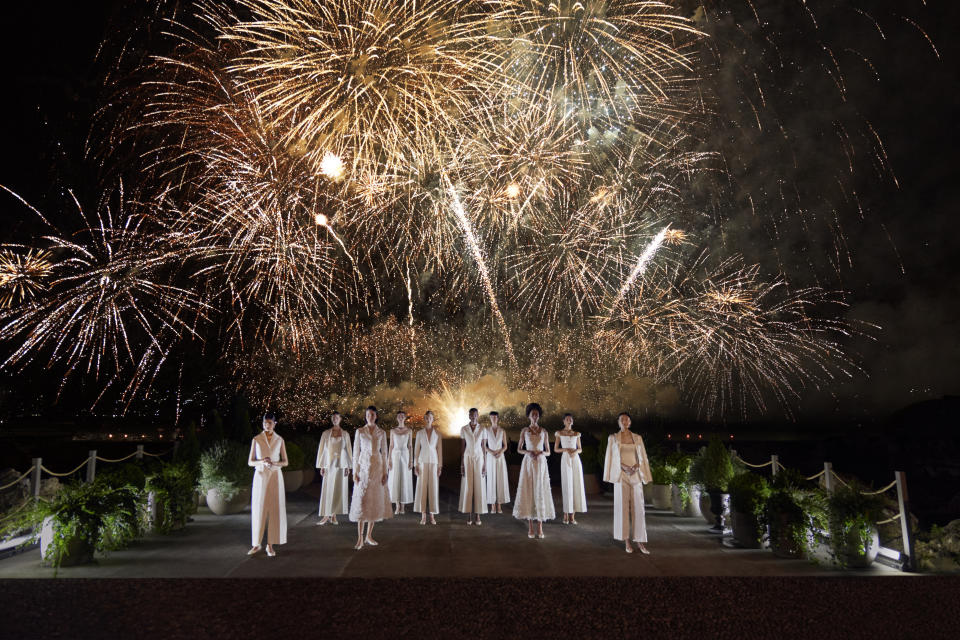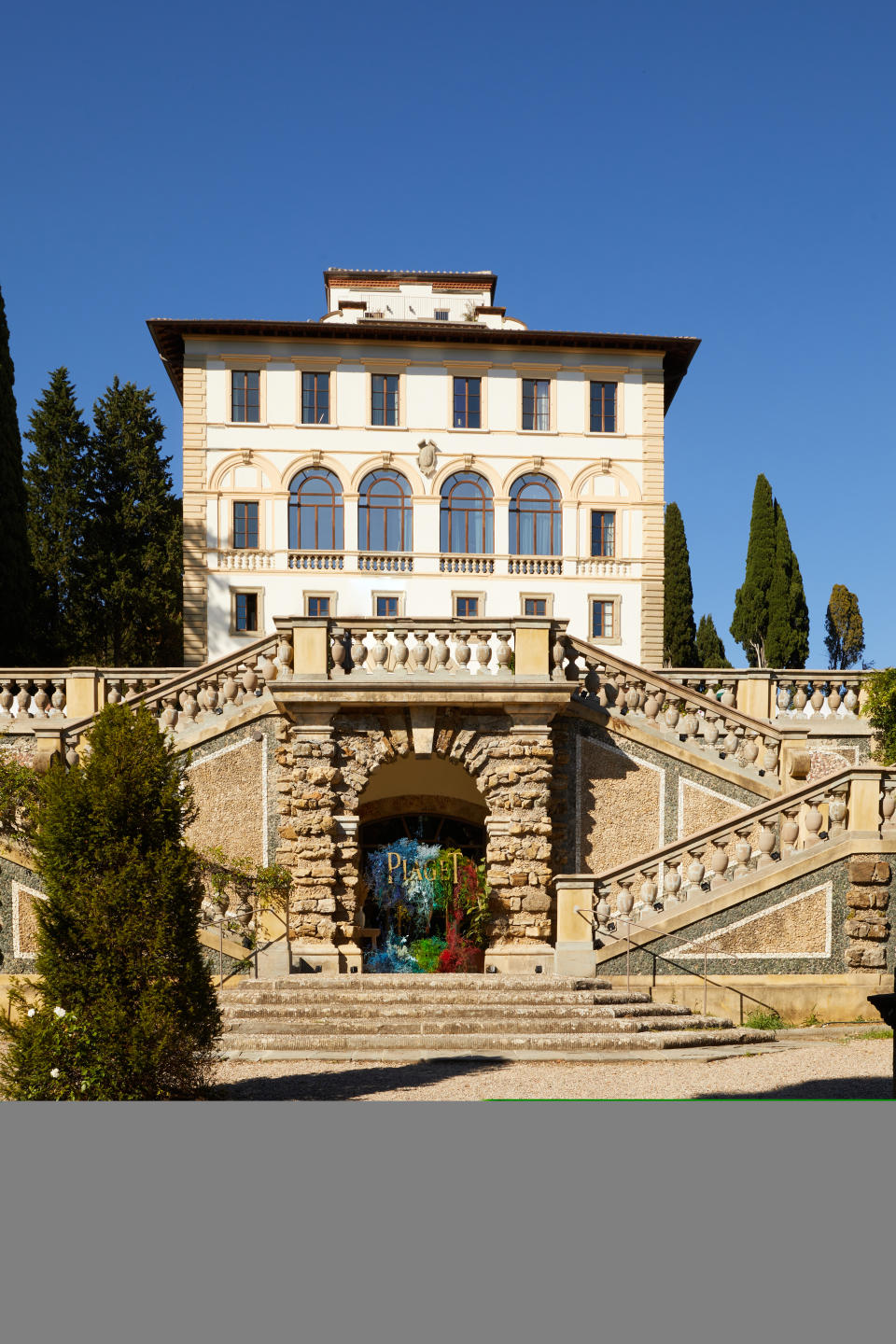Are High Jewelry Presentations the New Destination Show?

PARIS — Choosing the right jewels to go with a couture gown? In 2023, it’s the other way around.
By the time the latest collections hit the runway at Paris Couture Week, gems will have already been selected, purchased — and sometimes even worn — by their fortunate new owners.
More from WWD
Most of the high jewelry houses showcasing collections during the week, which runs from July 3 to 6, already presented their wares weeks and sometimes even months in advance during glitzy destination events — many in Italy this spring.
Staging these fancy and exclusive destination presentations offers several advantages for these brands, not least an investment that brings returns in light of the uber-luxe pieces driving growth in the top-performing watches and jewelry categories, according to a spring 2023 market study by Bain & Company with Altagamma.
While destination resort or cruise shows may be all about connecting with a territory’s audience and brand building, “for high jewelry it’s different, it’s about the relationship to the client, but it’s also an opportunity to buy,” said Mario Ortelli, managing partner of strategic mergers and acquisitions advisory firm Ortelli & Co. “These events are very important to create sales since when you invite your top customers, you sell a lot.”
Content is also an immediate result of these events, more so than the until-now traditional presentations. Between press, social media and the clients themselves posting snapshots of these glamorous slices of life, the events are an investment in the brand’s prestige.
It’s also a great way to create FOMO, since not all customers are invited, creating an aspiration toward the brand for the unhappy few watching the happy fewer.

The latter may be drawn to the destination, but also the opportunity to wear what is in — or joining — their collection. Cultural and social factors are affecting the geographies of the brand’s high jewelry customers, rather than age groups, according to Arnaud Carrez, senior vice president and chief marketing officer of Cartier International.
The executive noted that these kinds of pieces are more challenging to wear in Europe due to a reduced number of special occasions as well as the overall social and economic context, “inducing some of our clients to be cautious and have a more subdued approach,” he noted.
Conversely, social events in the U.S., Asia and Middle East spark the demand for such creations.
“That’s why events like this one [in Lucca, Italy] are very important for clients. It’s not only for commercial reasons but they are also an opportunity to wear their pieces, which is very important for them,” noted Carrez.
Plus, there is the definite thrill of one-upmanship at being able to wear one’s latest high jewelry purchases fresh off the model or display for the gala dinners that are par for the course at such destination events.
Establishing one-on-one connections in memorable settings is also what brands hope to get in return for their investment in destination events.
Offering an experience, “a souvenir” to remember is increasingly important to clients. “It’s more than just the purchase; the emotional content is very high. And it’s also a way to thank the clients for their support in addition to showing what we can do,” said Piaget CEO Benjamin Comar.
Louis Vuitton’s Francesca Amfitheatrof said meeting clients in person was key. This “creates a very special connection with the client, because I then go and really talk to them about why a piece was created that way, what the theme [is], what the real symbolic meaning [is],” she explained.
For the setting that was “meant to transport you” into the Deep Time collection, Greece “obviously has a purity and a sense of beauty that is innate and its culture, but also it is elemental” due to the natural features of the landscape and proximity to the sea, she said.
“These events allow our clients to travel to romantic and evocative locations, happy places, which either they never knew or maybe have known in different, other conditions,” said Victoire de Castellane, creative director of Dior Joaillerie.
Houses spared no expenses for their guests. Louis Vuitton hosted its guests at the Amanzoe resort in Greece for an event that culminated with a performance at the antique Odeon of Herodes Atticus theater at the foot of the Acropolis in Athens.
Cartier took over a 17th century estate fit for an Italian “Bridgerton,” complete with a lush park punctuated by sculptures, lemon gardens and a small lake. Van Cleef & Arpels headed to Rome to capture the idea of “real journeys through history and art.” Dior similarly staged a presentation at Villa Erba in Cernobbio, a small town near Como.
The ultra-Parisian house of Chanel crossed the Channel to show its 63-piece “Tweed de Chanel” collection, while Chaumet stuck closer to home, at the picturesque Château de Bagatelle with the Seine at its feet.
Ortelli said that after the travel disruptions due to the COVID-19 pandemic, bringing to Europe high jewelry clients, many hailing from the Middle East, Asia and America, was “a fantastic opportunity to enjoy the European summer.”
“It is not about where they are based, it is more about how we are able to emotionally connect with them, whoever they are, wherever they come from. Our approach transcends borders as we aim to establish one-on-one relationships with each individual client, offering them unique and personalized experiences,” said Gucci president and CEO Marco Bizzarri.
And given these clients’ lifestyles, there is no point starting a “race to destinations” when it comes to putting high jewelry in front of them, said Chanel’s president for watches and jewelry Frédéric Grangié, who felt reinforcing client expectations of “creation, know-how and ultimate quality [to be] the principal draw for them.”
“To make this kind of client travel, what is important is offering a comprehensive experience, one that can be simple — perhaps as simple as being barefoot in the grass outside La Pausa,” Gabrielle Chanel’s former country house, currently being restored by the company, said the executive.

In most cases, the destination was chosen to complement the collection’s theme, from the passion of Christian Dior for gardens to Piaget’s desire to pay homage to the “capital of the Renaissance” Florence, to symbolize creativity for the first big event of the post-pandemic era, Comar told WWD.
But destination high jewelry presentations also serve as a vehicle to build or reinforce brand equity.
According to Bizzarri, showing in Palazzo Settimanni, the brand’s historical archive in Florence was a statement on the house’s identity — it is where Guccio Gucci started the leather goods business in 1921.
Likewise at Chanel, where the choice was dictated by a theme unique to the house.
“For high jewelry as other fields, it’s about staying true to who we are, because that’s what creates loyalty to the brand,” Bizzarri said. “Our focus is always elevating the brand through the creations first, business being a result of this.”
Increasing destination presentations for high jewelry or watchmaking is a bid to court high-net-worth individuals, a consumer segment that is proving particularly resilient even as talks of recession and cost of living pressures make other consumers shy away from discretionary purchases.
In his opinion, luxury brands will continue to dedicate marketing budget to jewelry because it’s a segment that provides good returns but also brings in brand equity. “High jewelry, like haute couture, gives an allure to the brand that is incredible, but it’s also a highly profitable category,” said Ortelli, noting that high jewelry may account for 20 to even 25 percent of the jewelry revenue of some houses.
Although Italy was the main destination of the year, don’t read this as a shift of the center of gravity for the traditionally Paris-based high jewelry industry.
“The houses are looking for postcard Instagrammable locations and funnily enough, they ended up in Italy at the same time,” said Ortelli, who deemed the concentration of Italian destinations a coincidence and expects a broader geographical variety for the next round.
There are also more practical concerns that make European destinations attractive. With high jewelry a global business with clients from all over the world, Europe is the ideal midway point that is easy to access from most territories, with fewer challenges such as visas, he noted.

But before packing a go-bag for high jewelry, “let’s see how [long] this trend of ‘resort destination’ high jewelry showcases [lasts],” he continued. On the one hand, having people’s exclusive attention for a multiday event is an attractive proposal. But on the other, the environmental impact of such trips is already on the table, he continued.
And there will be plenty to see and do during couture week. While Louis Vuitton and Dior did not announce showings of their high jewelry, Cartier, Chanel and Piaget will put on intimate presentations for press and clients, showing a selection of already-seen pieces along new ones that are often fresh off the workbenches.
Others, including Mikimoto, Graff, Boucheron and a slew of independents like Ana Khouri and Elie Top, will be tapping into the haute couture clientele’s presence to show at mainstays like the Ritz hotel or in their Parisian flagships. Meanwhile, Repossi will be celebrating the 10th anniversary of its Antifer line with a garden party on July 5.
As for the Natural Diamond Council, it will be hosting a panel conversation between its global ambassador Lily James and and Livia Firth to discuss the environmental and social impact of the modern diamond industry.
Best of WWD


